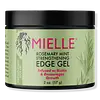What's inside
What's inside
 Key Ingredients
Key Ingredients

 Benefits
Benefits

 Concerns
Concerns

 Ingredients Side-by-side
Ingredients Side-by-side

Chenopodium Quinoa Seed Extract
Skin ConditioningCetearyl Alcohol
EmollientGlycerin
HumectantBrassicamidopropyl Dimethylamine
Skin ConditioningDipalmitoylethyl Dimonium Chloride
Ethylhexyl Palmitate
EmollientTriethylhexanoin
MaskingDecyl Cocoate
EmollientBehentrimonium Chloride
PreservativeCocos Nucifera Oil
MaskingSorbitan Olivate
EmulsifyingPrunus Amygdalus Dulcis Oil
Skin ConditioningCetearyl Olivate
Adansonia Digitata Seed Oil
EmollientPolyglyceryl-10 Laurate
Skin ConditioningCopper Tripeptide-1
Skin ConditioningAcetyl Hexapeptide-8
HumectantPalmitoyl Pentapeptide-4
Skin ConditioningPEG-4
HumectantPalmitoyl Tetrapeptide-7
Skin ConditioningPalmitoyl Tripeptide-1
Skin ConditioningCetearamidoethyldiethonium Succinoyl Hydrolyzed Pea Protein
CleansingAvena Sativa Protein Extract
Skin ConditioningCeramide NP
Skin ConditioningPentaclethra Macroloba Seed Oil
EmollientOlus Oil
EmollientTamarindus Indica Seed Polysaccharide
Skin ConditioningPanthenol
Skin ConditioningCitric Acid
BufferingTocopherol
AntioxidantMalt Extract
Skin ProtectingCetyl Palmitate
EmollientWater
Skin ConditioningIsopropyl Alcohol
SolventSorbitan Palmitate
EmulsifyingPolyglyceryl-10 Myristate
Skin ConditioningGuar Hydroxypropyltrimonium Chloride
Skin ConditioningCoco-Caprylate/Caprate
EmollientHydroxyethylcellulose
Emulsion StabilisingCaprylyl Glycol
EmollientButylene Glycol
HumectantIllicium Verum Fruit Extract
PerfumingLavandula Hybrida Oil
EmollientLinalool
PerfumingAniba Rosodora Wood Oil
AstringentCananga Odorata Flower Oil
MaskingPelargonium Graveolens Flower Oil
MaskingSodium Acetate
BufferingCellulose
Absorbent1,2-Hexanediol
Skin ConditioningChenopodium Quinoa Seed Extract, Cetearyl Alcohol, Glycerin, Brassicamidopropyl Dimethylamine, Dipalmitoylethyl Dimonium Chloride, Ethylhexyl Palmitate, Triethylhexanoin, Decyl Cocoate, Behentrimonium Chloride, Cocos Nucifera Oil, Sorbitan Olivate, Prunus Amygdalus Dulcis Oil, Cetearyl Olivate, Adansonia Digitata Seed Oil, Polyglyceryl-10 Laurate, Copper Tripeptide-1, Acetyl Hexapeptide-8, Palmitoyl Pentapeptide-4, PEG-4, Palmitoyl Tetrapeptide-7, Palmitoyl Tripeptide-1, Cetearamidoethyldiethonium Succinoyl Hydrolyzed Pea Protein, Avena Sativa Protein Extract, Ceramide NP, Pentaclethra Macroloba Seed Oil, Olus Oil, Tamarindus Indica Seed Polysaccharide, Panthenol, Citric Acid, Tocopherol, Malt Extract, Cetyl Palmitate, Water, Isopropyl Alcohol, Sorbitan Palmitate, Polyglyceryl-10 Myristate, Guar Hydroxypropyltrimonium Chloride, Coco-Caprylate/Caprate, Hydroxyethylcellulose, Caprylyl Glycol, Butylene Glycol, Illicium Verum Fruit Extract, Lavandula Hybrida Oil, Linalool, Aniba Rosodora Wood Oil, Cananga Odorata Flower Oil, Pelargonium Graveolens Flower Oil, Sodium Acetate, Cellulose, 1,2-Hexanediol
Water
Skin ConditioningCeteareth-25
CleansingGlycerin
HumectantPEG-7 Glyceryl Cocoate
EmulsifyingPEG-40 Hydrogenated Castor Oil
EmulsifyingPropylene Glycol
HumectantEthylhexylglycerin
Skin ConditioningOlea Europaea Fruit Oil
MaskingMentha Piperita Oil
MaskingRosmarinus Officinalis Leaf Oil
MaskingEquisetum Arvense Extract
AstringentOrbignya Oleifera Seed Oil
EmollientZingiber Officinale Root Oil
MaskingCocos Nucifera Oil
MaskingHoney
HumectantBiotin
AntiseborrhoeicLawsonia Inermis Extract
AntimicrobialRosmarinus Officinalis Extract
AntimicrobialHumulus Lupulus Extract
AntimicrobialUrtica Dioica Extract
AstringentPhenoxyethanol
PreservativeAnthemis Nobilis Flower Extract
MaskingSymphytum Officinale Callus Culture Extract
Skin ConditioningBenzoic Acid
MaskingGlycereth-2 Cocoate
EmulsifyingParfum
MaskingWater, Ceteareth-25, Glycerin, PEG-7 Glyceryl Cocoate, PEG-40 Hydrogenated Castor Oil, Propylene Glycol, Ethylhexylglycerin, Olea Europaea Fruit Oil, Mentha Piperita Oil, Rosmarinus Officinalis Leaf Oil, Equisetum Arvense Extract, Orbignya Oleifera Seed Oil, Zingiber Officinale Root Oil, Cocos Nucifera Oil, Honey, Biotin, Lawsonia Inermis Extract, Rosmarinus Officinalis Extract, Humulus Lupulus Extract, Urtica Dioica Extract, Phenoxyethanol, Anthemis Nobilis Flower Extract, Symphytum Officinale Callus Culture Extract, Benzoic Acid, Glycereth-2 Cocoate, Parfum
 Reviews
Reviews

Ingredients Explained
These ingredients are found in both products.
Ingredients higher up in an ingredient list are typically present in a larger amount.
Cocos Nucifera Oil is obtained from the kernels of the coconut fruit. In other words, this is coconut oil.
Coconut Oil is rich in fatty acids with lauric acid making up the majority of these. It also contains linoleic acid. Due to this high fatty acid content, coconut oil helps trap moisture and soften skin.
Despite being antibacterial, coconut oil may not be great for acne-prone skin. It is comedogenic and may clog pores. This ingredient may not be safe for malassezia or fungal acne.
Note: Coconut Oil should not replace your sunscreen for UV protection. Studies show it only blocks about 20% of UV.
This oil is non-volatile and has a light scent.
The term 'fragrance' is not regulated in many countries. In many cases, it is up to the brand to define this term. For instance, many brands choose to label themselves as "fragrance-free" because they are not using synthetic fragrances. However, their products may still contain ingredients such as essential oils that are considered a fragrance.
Learn more about Cocos Nucifera OilGlycerin is already naturally found in your skin. It helps moisturize and protect your skin.
A study from 2016 found glycerin to be more effective as a humectant than AHAs and hyaluronic acid.
As a humectant, it helps the skin stay hydrated by pulling moisture to your skin. The low molecular weight of glycerin allows it to pull moisture into the deeper layers of your skin.
Hydrated skin improves your skin barrier; Your skin barrier helps protect against irritants and bacteria.
Glycerin has also been found to have antimicrobial and antiviral properties. Due to these properties, glycerin is often used in wound and burn treatments.
In cosmetics, glycerin is usually derived from plants such as soybean or palm. However, it can also be sourced from animals, such as tallow or animal fat.
This ingredient is organic, colorless, odorless, and non-toxic.
Glycerin is the name for this ingredient in American English. British English uses Glycerol/Glycerine.
Learn more about GlycerinWater. It's the most common cosmetic ingredient of all. You'll usually see it at the top of ingredient lists, meaning that it makes up the largest part of the product.
So why is it so popular? Water most often acts as a solvent - this means that it helps dissolve other ingredients into the formulation.
You'll also recognize water as that liquid we all need to stay alive. If you see this, drink a glass of water. Stay hydrated!
Learn more about Water